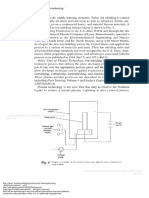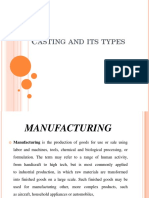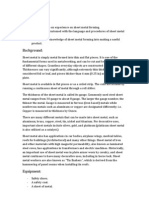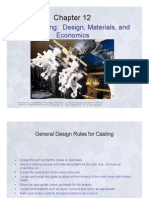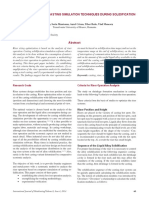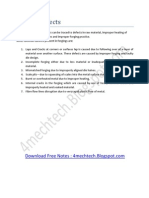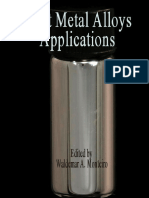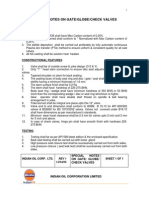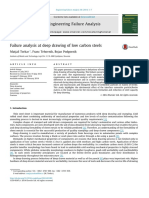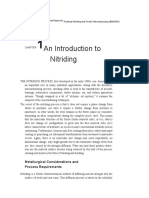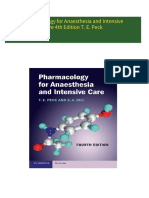Nitriding
Nitriding
Uploaded by
Shashidhar Ks KadamaCopyright:
Available Formats
Nitriding
Nitriding
Uploaded by
Shashidhar Ks KadamaOriginal Title
Copyright
Available Formats
Share this document
Did you find this document useful?
Is this content inappropriate?
Copyright:
Available Formats
Nitriding
Nitriding
Uploaded by
Shashidhar Ks KadamaCopyright:
Available Formats
2003 ASM International. All Rights Reserved.
Practical Nitriding and Ferritic Nitrocarburizing (#06950G)
www.asminternational.org
CHAPTER
1
An Introduction to Nitriding
THE NITRIDING PROCESS, rst developed in the early 1900s, continues to play an important role in many industrial applications. Along with the derivative nitrocarburizing process, nitriding often is used in the manufacture of aircraft, bearings, automotive components, textile machinery, and turbine generation systems. Though wrapped in a bit of alchemical mystery, it remains the simplest of the case hardening techniques. The secret of the nitriding process is that it does not require a phase change from ferrite to austenite, nor does it require a further change from austenite to martensite. In other words, the steel remains in the ferrite phase (or cementite, depending on alloy composition) during the complete procedure. This means that the molecular structure of the ferrite (body-centered cubic, or bcc, lattice) does not change its conguration or grow into the face-centered cubic (fcc) lattice characteristic of austenite, as occurs in more conventional methods such as carburizing. Furthermore, because only free cooling takes place, rather than rapid cooling or quenching, no subsequent transformation from austenite to martensite occurs. Again, there is no molecular size change and, more importantly, no dimensional change, only slight growth due to the volumetric change of the steel surface caused by the nitrogen diffusion. What can (and does) produce distortion are the induced surface stresses being released by the heat of the process, causing movement in the form of twisting and bending.
Metallurgical Considerations and Process Requirements
Nitriding is a ferritic thermochemical method of diffusing nascent nitrogen into the surface of steels and cast irons. This diffusion process is based on the solubility of nitrogen in iron, as shown in the iron-nitrogen equilibrium diagram (Fig. 1).
2 / Practical Nitriding and Ferritic Nitrocarburizing
2003 ASM International. All Rights Reserved. Practical Nitriding and Ferritic Nitrocarburizing (#06950G)
www.asminternational.org
Iron-nitrogen equilibrium diagram. The -phase, not shown on this diagram, exists from 11.0 to 11.35% N at temperatures below approximately 500 C (930 F).
Fig. 1
The solubility limit of nitrogen in iron is temperature dependent, and at 450 C (840 F) the iron-base alloy will absorb up to 5.7 to 6.1% of N. Beyond this, the surface phase formation on alloy steels tends to be predominantly epsilon () phase. This is strongly inuenced by the carbon content of the steel; the greater the carbon content, the more potential for the phase to form. As the temperature is further increased to the gamma prime () phase temperature at 490 C (914 F), the window or limit of solubility begins to decrease at a temperature of approximately 680 C (1256 F). The equilibrium diagram shows that control of the nitrogen diffusion is critical to process success (Fig. 1). A number of operating process parameters must be adhered to and controlled in order to successfully carry out the nitriding process. Most of these parameters can be controlled with relatively simple instrumentation and methods. Examples of process parameters for gas nitriding include: Furnace temperature Process control (see discussion below) Time Gas ow Gas activity control Process chamber maintenance
All these factors help to reduce distortion during the process, with the exception of induced residual stresses. Another benet of nitriding is that it acts as a stabilizing process by providing an additional temper to the processed steel.
2003 ASM International. All Rights Reserved. Practical Nitriding and Ferritic Nitrocarburizing (#06950G)
www.asminternational.org
Chapter 1: An Introduction to Nitriding / 3
Control of the process parameters is necessary to ensure formation of an acceptable metallurgical case. Without control, repeatability of the metallurgical requirements cannot be guaranteed. The process control factors are those elements that will ensure a controlled process and acceptable results: Total surface area to be nitrided Process pressure inside the sealed process chamber Gas delivery pressure system into the sealed process chamber Exhaust gas system from the sealed process chamber Control of the preheat treatment procedure prior to nitriding, including stress relief and prehardening and tempering Quality and integrity of the steel surface precleaning prior to nitriding Consistent steel chemistry to maximize nitridability
The Pioneering Work of Machlet
In the early years of the 20th century, Adolph Machlet worked as a metallurgical engineer for the American Gas Company in Elizabeth, NJ. He recognized that the surface hardening technique of carburizing led to distortion problems due to extended periods at elevated temperatures, followed by severe quenching into either water or oil. Through experimentation, Machlet soon discovered that nitrogen was very soluble in iron. Nitrogen diffusion produced a relatively hard surface in simple plain irons or low-alloy steels and signicantly improved corrosion resistance. This was accomplished without subjecting the steel to elevated temperatures and, more importantly, without cooling the steel rapidly to achieve a hard wearing surface. It could now cool freely within the process chamber, while still under the protection of the nitrogen-based atmosphere, thus reducing the risk of distortion yet still producing a hard, wear-resistant surface with good corrosion resistance. Ammonia was decomposed, or cracked, by heat to liberate the nascent nitrogen necessary for the process. It was not long before Machlet realized that he needed to control the decomposition accurately. He did this by using hydrogen as a dilutant gas to reduce the amount of available nascent nitrogen, thus controlling to some extent the formed case metallurgy. His reasoning behind the control of the process gas was recognition of what is now known as the white layer or compound zone. Figure 2 shows a simple construction of the nitrided case. It should be noted that this schematic is not to scale. The rst patent for the development of the nitriding process was applied for in March 1908 in Elizabeth, NJ. The patent was nally approved in June 1913, some ve years after the initial application. Machlet had been working for a number of years on the process prior to his patent application
4 / Practical Nitriding and Ferritic Nitrocarburizing
2003 ASM International. All Rights Reserved. Practical Nitriding and Ferritic Nitrocarburizing (#06950G)
www.asminternational.org
Compound zone, dual phase Diffusion zone consisting of formed nitrides Transition zone from diffusion zone to core material
Core material
Fig. 2
Schematic of a typical nitrided case structure
and continued to develop both the new process and his understanding of the resulting process metallurgy. The patent was for The Nitrogenization of Iron and Steel in an Ammonia Gas Atmosphere into which an Excess of Hydrogen Has Been Introduced (Ref 1). Although Machlets development and patenting of the new nitriding procedure was technologically important, his work remained largely unrecognized and faded into obscurity. Even today, very few nitriding practitioners know who he was and what he accomplished. Most metallurgists who are familiar with the nitriding process know the work of the German researcher Adolph Fry, who is recognized as the father of nitriding. While Frys work was more publicized and his methods were taught at many ne metallurgical academic institutions, it was Machlet who rst pioneered the nitriding process.
Parallel Work in Europe
Adolph Fry. In Germany, a parallel research program was under way at the Krupp Steel Works in Essen. This program was headed by Dr. Adolph Fry in 1906. Like Machlet, Fry recognized that nitrogen was very soluble in iron at an elevated temperature. He also recognized very early in his work that alloying elements strongly influenced metallurgical and performance results. Fry first applied for his patent in 1921, three years after the First World War ended. His patent was granted in March 1924 (Ref 2). He used a technique similar to that of Machlet, where the nitrogen source had to be cracked by heat to liberate nitrogen for reaction and diffusion. Like Machlet, Fry used ammonia as the source gas, but he did not use hydrogen as a dilutant gas. Thus was developed the single-stage gas nitriding process as it is known today. Fry then investigated the effects of alloying elements on surface hardness. He discovered that the nitriding process produced a high surface hardness only on steels containing chromium, molybdenum, aluminum,
2003 ASM International. All Rights Reserved. Practical Nitriding and Ferritic Nitrocarburizing (#06950G)
www.asminternational.org
Chapter 1: An Introduction to Nitriding / 5
vanadium, and tungsten, all of which form what are known as stable nitrides. He also discovered the critical nature of process temperature in terms of case depth and surface metallurgy. Processing the steel at higher temperatures placed the surface at risk to form what is known today as nitride networks (a saturated solution of nitrogen in the immediate surface of the formed case). Because steels with higher alloy contents were not readily available for nitriding, Fry became responsible for developing a group of steels for Krupp known as the Nitralloy group. These steels, specically designed as nitriding steels, soon became internationally recognized. Even today the Nitralloy steels are specied. British Standard Nitriding Steels. Shortly thereafter in the late 1920s, a company in Shefeld, England, also began work on developing a group of nitriding steels under the licensed guidance of Krupp Steels. These steels were also marketed under the brand name of Nitralloy. The company was Thomas Firth and John Brown Steelworks, more commonly known as Firth Brown Steels. The steels from Firth Brown were known as the LK group, designated by British Standard 970 as En 40 A, En 40 B, En 40 C, En 41 A, and En 41 B. Developed for nitriding applications, these were chromium-molybdenum steels (see Table 1 for chemical compositions). The En 41 series contained aluminum, which produced a much higher surface hardness after nitriding. Aluminum has a strong afnity for nitrogen, forming very hard aluminum nitrides that are quite stable in amounts up to 1.0% Al. Much above 1.0%, aluminum has no effect on the resultant nitriding hardness. Differences Between the U.S. and German Processes. The principal differences between the process developed in the United States and that developed in Germany were that: The U.S. process used hydrogen as a dilutant gas to control the nitriding potential of both the gas and steel, which in turn controlled the nal surface metallurgy. The Germans manipulated the process through alloying and improved on such aspects as core hardness and tensile strength.
Table 1 British standard nitriding steels
Composition, % Designation(a) C Si Mn P Cr Mo Ni V Al
En 40 A En 40 B En 40 C En 41 A En 41 B
0.200.35 0.200.30 0.300.50 0.250.35 0.250.45
0.100.3 0.100.35 0.100.35 0.100.35 0.100.35
0.400.55 0.400.65 0.400.80 0.65 max 0.65 max
0.05 max 0.05 max 0.05 max 0.05 max 0.05 max
2.904.00 2.903.50 2.903.50 1.401.80 1.401.80
0.600.80 0.400.70 0.701.20 0.100.25 0.100.25
0.40 max 0.40 max 0.40 max 0.40 max 0.40 max
... 0.100.30 0.100.30 ... ...
... ... ... 0.901.30 0.901.30
(a) The international designation for En 40 A, B, and C is 31 CrMoV 9. En 41 A and B are designated 34 CrAlMo 5. max, maximum
6 / Practical Nitriding and Ferritic Nitrocarburizing
2003 ASM International. All Rights Reserved. Practical Nitriding and Ferritic Nitrocarburizing (#06950G)
www.asminternational.org
Machlets process was not widely accepted in the United States, as it was perceived to have little if any commercial value to U.S. industry. By contrast, the Germans exploited Frys process in the early years following WWI. The German process enjoyed great success throughout Europe in the aircraft, textile, railroad, automotive, and machine tool industries. During the mid to late 1920s, information about Frys success began to lter through to American industrialists, prompting the Society of Manufacturing Engineers (SME) to take a strong interest in the German developments. This led to SME sending Dr. Zay Jeffries from Cleveland, OH, to Germany to visit Krupp Steel and Dr. Fry in 1926. It was at this meeting that Jeffries suggested to Fry that he attend the forthcoming annual SME conference in Chicago and present a paper on the process techniques and applications. Fry could not attend, so his friend and colleague Pierre Aubert made a presentation on his behalf. The presentation helped bring about commercialization of the process in the United States.
Developments in the United States
Following the presentation of Frys work at the 1927 SME conference, American metallurgists began exploring nitriding processing parameters and the effects of alloying on the nitriding response of steels. Some of the more notable studies are described later in this chapter. McQuaid and Ketcham. Metallurgists H.W. McQuaid and W.J. Ketcham at the Timken Detroit Axle Company in Detroit, MI conducted a series of investigations to evaluate the new nitriding process. The studies were completed during a two-year period, which concluded with a presentation of their ndings in 1928 (Ref 3). In general, the investigatory work focused on process temperature. The temperatures selected ranged from 540 to 650 C (1000 to 1200 F). The upper temperature was signicantly lower than the temperatures employed by Machlet, which ranged from 480 to 980 C (900 to 1800 F). McQuaid and Ketcham concluded that higher nitriding temperatures had an effect on core hardness of alloy steels but little effect on the ability to nitride at those temperatures. They also found that higher process temperatures increased the risk of forming nitride networks, particularly at corners, due to the higher solubility of nitrogen in iron. When present, nitride networks cause premature failure at the steel surface by cracking and exfoliation. McQuaid and Ketcham began an exhaustive series of investigations into the new process of nitriding as developed by Machlet and Fry. The studies included: Inuence of temperature on both case formation and case depth Inuence of alloying elements in the newly developed Nitralloy steels Inuence of temperature on growth and distortion Inuence of time on case depth distortion and growth
2003 ASM International. All Rights Reserved. Practical Nitriding and Ferritic Nitrocarburizing (#06950G)
www.asminternational.org
Chapter 1: An Introduction to Nitriding / 7
Effects of the ammonia/hydrogen relationship and dilution by hydrogen Effects of slow and rapid cooling, such as controlled cooling in the process retort by the introduction of air and rapid cooling in water
They concluded that nitriding was much easier to control than carburizing. They also found that the corrosion properties of low-alloy and alloy steels were much improved while undergoing salt spray tests and that practically any steel can be nitrided, including plain carbon steel and pure iron. McQuaid and Ketcham were also the rst early metallurgists to study the white layer or compound zone. They concluded that the white structure is composed of a nitride, either iron nitrides or a complex nitride layer, involving both iron and alloying elements. A further conclusion was that the white layer or compound zone was extremely hard but very brittle and that the layer should be avoided if possible (though no specic guidelines were offered). They also studied the effect of decarburization on nitrogen diffusion and the mechanical strength of the nitrided case. Their results showed that the steel to be nitrided should clearly be free of surface decarburization; otherwise, the nitrided surface will exfoliate and peel away from the substrate. They concluded that rough machining or some other operation to ensure complete removal of any decarburized surface layer should be performed before carrying out any nitride operation. Robert Sergeson was associated with the research laboratories of the Central Alloy Steel Corporation in Canton, Ohio. He presented a paper in July 1929 that reviewed the work of Dr. Fry on steels containing chromium, aluminum, molybdenum, vanadium, and tungsten (Ref 4). In unison with McQuaid and Ketcham, Sergeson concluded that process chemistry and process control in nitriding were much simpler than in carburizing. He also reviewed the effect of reheating on the case after nitriding and found that, with increasing temperature, case hardness stability was much better than for carburized and quenched alloy steel. He noted that the surface hardness value for a chromium-aluminum steel began to decrease at only 525 C (1000 F), and only slightly. He worked with many more steels and compared the effect of temperature on both nitrided alloy steels and carburized and quenched alloy steels, yielding similar results. The process equipment that he used for his nitriding experiments was not unlike many modern gas nitriding furnaces, despite their improved materials of construction and computerized process control (Fig. 3). Sergeson examined the effect of both temperature and process gas ow on alloy steels and found that if the ammonia gas ow rate was increased at 510 C (950 F), little difference resulted in the immediate surface hardness and case depth. He also found that as process temperature increased, case depth increased but surface hardness decreased. His work covered alloy steels with chromium and aluminum and investigated the effects of varying aluminum and nickel contents. He concluded that nickel was not a nitride-forming element, but that it tended to retard
8 / Practical Nitriding and Ferritic Nitrocarburizing
2003 ASM International. All Rights Reserved. Practical Nitriding and Ferritic Nitrocarburizing (#06950G)
www.asminternational.org
Door lift mechanism Fan drive motor
Air circulating fan Furnace door
Refractory insulation
Exhaust ammonia gas outlet tube To atmosphere exhaust Process delivery gas (ammonia)
Furnace thermocouple Nitride process chamber Process chamber thermocouple tube Ammonia gas inlet tube
Load preparation table
Fig. 3
Schematic of a simple ammonia gas nitriding furnace
the nascent nitrogen diffusion if present in signicant quantities. More detailed information on alloying effects can be found in Chapter 12, Steels for Nitriding. V.O. Homerberg and J.P. Walsted. Professor Homerberg was an associate professor of metallurgy at the Massachusetts Institute of Technology and consulted for the Ludlum Steel Company. Mr. Walsted was an instructor at the same university at the time that they presented their ndings on the nitriding process (Ref 5). They studied the effects of temperature up to 750 C (1400 F), with its resulting increase in case depth but reduction of surface hardness. In addition, they studied the effects of decarburization on a nitrided surface and concluded that surfaces must be free of decarburization prior to nitriding. They reviewed Frys process technique and the decomposition of ammonia under heat. Once again, the equipment used for their experiments was not unlike the furnaces of today (with the exception, of course, of improved engineering materials of construction and furnace aesthetics).
Other Early Developments
The Floe Process. During the early days of nitriding process technology, a persistent phenomenon was observed: an ever-present white layer on the nitrided steel surface. The white layer was identied as a multi-
2003 ASM International. All Rights Reserved. Practical Nitriding and Ferritic Nitrocarburizing (#06950G)
www.asminternational.org
Chapter 1: An Introduction to Nitriding / 9
phase compound layer of and phases. Much recognition was given to Dr. Carl F. Floe of the Massachusetts Institute of Technology, who not only performed major research regarding identication of the layer and its characteristics, but also developed a process technique to reduce the layer thickness (Ref 6). Today that technique is known as the Floe process, or the two-stage process. The Floe process is carried out as two distinct events. The rst portion of the cycle is accomplished as a normal nitriding cycle at a temperature of about 500 C (930 F) with 15 to 30% dissociation of the ammonia (i.e., an atmosphere that contains 70 to 85% ammonia). This will produce the nitrogen-rich compound at the surface. Once the cycle is complete, the furnace temperature is increased to approximately 560 C (1030 F), with gas dissociation increased to 75 to 85% (i.e., an atmosphere that contains 15 to 25% ammonia). Very careful gas ow control of the ammonia and its dissociation must be maintained during the second stage of the process. The two-stage process is used to reduce formation of the compound zone only; it serves no other purpose. Salt Bath Nitriding. Shortly after the development of gas nitriding, alternative methods of nitriding were sought. One such method was the use of molten salt as a nitrogen source. The salt bath process uses the principle of the decomposition of cyanide to cyanate and the liberation of nitrogen within the salt for diffusion into the steel surface. Salt bath nitriding is described in greater detail in Chapter 6. The ion, or plasma, nitriding process, which is based on the familiar chemistry of gas nitriding, uses a plasma discharge of reaction gases both to heat the steel surface and to supply nitrogen ions for nitriding (see Chapter 8 for details). The process dates back to the work of a German physicist, Dr. Wehnheldt, who in 1932 developed what he called the glow discharge method of nitriding. Wehnheldt encountered severe problems with the control of the glow discharge. He then partnered with a Swiss physicist and entrepreneur Dr. Bernhard Berghaus. Together they stabilized the process and later formed the company Klockner Ionen GmbH, specializing in the manufacture of ion nitriding equipment. Although the ion nitriding process developed by Wehnheldt and Berghaus was used successfully by German industrialists during World War II, it was not used extensively because it was considered too complex, too expensive, and too unreliable to guarantee consistent and repeatable results. Not until the 1970s did the process gain industrial acceptance, particularly in Europe. The signicance of the glow discharge process was that it did not rely on the decomposition or cracking of a gas to liberate nascent nitrogen on the steel surface. The process was based on the ionization of a single molecular gas, which is nitrogen, and the liberation of nitrogen ions. The process offered a shorter cycle time due to the steel surface preparation and the gas ionization. Nitriding was not now restricted to steels that
10 / Practical Nitriding and Ferritic Nitrocarburizing
2003 ASM International. All Rights Reserved. Practical Nitriding and Ferritic Nitrocarburizing (#06950G)
www.asminternational.org
required specic nitride-forming elements. Today ion nitriding is carried out on virtually all steels and cast irons as well as refractory metals, aluminum (not yet on a commercial basis), and sintered ferrous materials. A schematic of an ion nitriding furnace layout is shown in Fig. 4. Ion Nitriding Production in the U.S. After WWII and through the late 1950s, the General Electric Company of Lynn, Massachusetts, operated a laboratory known as the Electromechanical Engineering and Physics Unit. Dr. Claude Jones and Dr. Derek Sturges, along with Stuart Martin, developed the rst ion nitriding unit in the United States and applied the process to a variety of materials and parts. Their ion nitriding units met all normal nitriding standards and were accepted by the U.S. Navy. Summaries of the properties, applications, and advantages associated with the process were published in 1964 (Ref 7) and 1973 (Ref 8). Other Uses of Plasma Technology. Ion nitriding is not the only heat treatment process that utilizes the glow discharge phenomenon. Simply put, if one uses the appropriate process gases and the proper furnace, the glow discharge technique can be applied to plasma-assisted ferritic nitrocarburizing, carburizing, carbonitriding, and chemical vapor deposition. These plasma-assisted processes are described in various publications, including Heat Treating, Volume 4 and Surface Engineering, Volume 5 of ASM Handbook. Plasma technology is not new. One has only to observe the Northern Lights to witness a natural plasma. Lightning is also a natural plasma.
Vacuum process vessel Work piece
Process gas manifold (nitrogen, argon)
Power source
Vacuum pump
Fig. 4
Simple schematic of the layout of an early plasma (ion) nitriding furnace system
2003 ASM International. All Rights Reserved. Practical Nitriding and Ferritic Nitrocarburizing (#06950G)
www.asminternational.org
Chapter 1: An Introduction to Nitriding / 11
Neon signs are a plasma glow, and lumina storms found in gift shops are just a few of the many examples of plasma technology at work.
Current Status of Nitriding Technology
The success of any heat treatment is measured by hardness. However, hardness is relevant to the materials application and its mechanical requirements. Nitriding often is applied to low-alloy steels to harden the steel and improve corrosion resistance. In addition to conventional nitriding, the following processes have been developed: Oxynitride process, during which a controlled postoxidation treatment is carried out to further enhance the surface corrosion resistance Ferritic nitrocarburizing (a controlled process using nitrogen and carbon to enhance surface characteristics of low-alloy steels) Derivatives of the two previous processes Controlled nitriding, which is a further development of traditional gas nitriding in which all the process parameters are computer controlled
Nitriding has reached maturity and become an accepted, though sometimes misunderstood, process. Both the gas and salt systems have run an almost parallel course since the early part of the 20th century. The process has found its place in both low- and high-tech applications and is becoming better understood by process technicians, metallurgists, applications engineers, furnace designers, and academics. Many developments in process techniques are being driven by environmental concerns and legislation. This has resulted in the introduction of more effective, efcient, and economical methods and equipment. Improvements can be seen in the development of gaseous methods, salt bath methods, uidized-bed methods, and plasma processing techniques. REFERENCES 1. A. Machlet, U.S. Patent 1,092,925, 24 June 1913 2. A. Fry, U.S. Patent 1,487,554, 18 March 1924 3. H.W. McQuaid and W.J. Ketcham, Some Practical Aspects of the Nitriding Process, reprinted from Trans. ASST, Vol 14, 1928, Source Book on Nitriding, P.M. Unterweiser and A.G. Gray, Ed., American Society for Metals, 1977, p 125 4. R. Sergeson, Investigation in Nitriding, reprinted from American Society for Steel Treaters (ASST) Nitriding Symposium, 1929, in Source Book on Nitriding, P.M. Unterweiser and A.G. Gray, Ed., American Society for Metals, 1977, p 2655 5. V.O. Homerberg and J.P. Walsted, A Study of the Nitriding Process Part I, reprinted from American Society for Steel Treaters (ASST) Nitriding Symposium, 1929, in Source Book on Nitriding, P.M. Unterweiser and A.G. Gray, Ed., American Society for Metals, 1977, p 5699
12 / Practical Nitriding and Ferritic Nitrocarburizing
2003 ASM International. All Rights Reserved. Practical Nitriding and Ferritic Nitrocarburizing (#06950G)
www.asminternational.org
6. C.F. Floe, A Study of the Nitriding Process Effect of Ammonia Dissociation on Case Depth and Structure, reprinted from Trans. ASM, Vol 32, 1944, Source Book on Nitriding, P.M. Unterweiser and A.G. Gray, Ed., American Society for Metals, 1977, p 144171 7. C.K. Jones and S.W. Martin, Nitriding, Sintering and Brazing in Glow Discharge, Met. Prog., Feb 1964, p 9498 8. C.K. Jones, D.J. Sturges, and S.W. Martin, Glow-Discharge Nitriding in Production, reprinted from Met. Prog., Dec 1973, Source Book on Nitriding, P.M. Unterweiser and A.G. Gray, Ed., American Society for Metals, 1977, p 186187
ASM International is the society for materials
engineers and scientists, a worldwide network dedicated to advancing industry, technology, and applications of metals and materials. ASM International, Materials Park, Ohio, USA www.asminternational.org This publication is copyright ASM International. All rights reserved. Publication title
Practical Nitriding and Ferritic Nitrocarburizing To order products from ASM International: Online Visit www.asminternational.org/bookstore Telephone 1-800-336-5152 (US) or 1-440-338-5151 (Outside US) Fax 1-440-338-4634 Mail
Product code
#06950G
Customer Service, ASM International 9639 Kinsman Rd, Materials Park, Ohio 44073-0002, USA
Email CustomerService@asminternational.org
American Technical Publishers Ltd. 27-29 Knowl Piece, Wilbury Way, Hitchin Hertfordshire SG4 0SX, In Europe United Kingdom
Telephone: 01462 437933 (account holders), 01462 431525 (credit card)
www.ameritech.co.uk Neutrino Inc. In Japan Takahashi Bldg., 44-3 Fuda 1-chome, Chofu-Shi, Tokyo 182 Japan Telephone: 81 (0) 424 84 5550
Terms of Use. This publication is being made available in PDF format as a benefit to members and
customers of ASM International. You may download and print a copy of this publication for your personal use only. Other use and distribution is prohibited without the express written permission of ASM International. No warranties, express or implied, including, without limitation, warranties of merchantability or fitness for a particular purpose, are given in connection with this publication. Although this information is believed to be accurate by ASM, ASM cannot guarantee that favorable results will be obtained from the use of this publication alone. This publication is intended for use by persons having technical skill, at their sole discretion and risk. Since the conditions of product or material use are outside of ASM's control, ASM assumes no liability or obligation in connection with any use of this information. As with any material, evaluation of the material under end-use conditions prior to specification is essential. Therefore, specific testing under actual conditions is recommended. Nothing contained in this publication shall be construed as a grant of any right of manufacture, sale, use, or reproduction, in connection with any method, process, apparatus, product, composition, or system, whether or not covered by letters patent, copyright, or trademark, and nothing contained in this publication shall be construed as a defense against any alleged infringement of letters patent, copyright, or trademark, or as a defense against liability for such infringement.
You might also like
- MMPL-PSA-02-Casting Surface Defect Acceptance Standard - Brake - DrumsDocument1 pageMMPL-PSA-02-Casting Surface Defect Acceptance Standard - Brake - DrumsVishal MaliNo ratings yet
- Saes S 007Document17 pagesSaes S 007nadeem shaikhNo ratings yet
- HDCV 5000 ManualDocument30 pagesHDCV 5000 ManualaleksandrNo ratings yet
- Sym Fiddle125 Service ManualDocument182 pagesSym Fiddle125 Service Manualdanielaat100% (1)
- Microstructure of Nitrided SteelsDocument5 pagesMicrostructure of Nitrided Steelsmp87_ingNo ratings yet
- Types of Sand Casting Tools and Equipment - StudentlessonDocument12 pagesTypes of Sand Casting Tools and Equipment - Studentlessonmallikahot100% (1)
- Practical Nitriding and Ferritic Nitrocarburizing 22 To 32Document11 pagesPractical Nitriding and Ferritic Nitrocarburizing 22 To 32StivenSanchezNo ratings yet
- Heat TreamentDocument9 pagesHeat TreamentAtul GaurNo ratings yet
- 4-Machining Fundamentals Ams May01 13Document87 pages4-Machining Fundamentals Ams May01 13mjdaleneziNo ratings yet
- Cast Iron Basic Training and ApplicatonsDocument34 pagesCast Iron Basic Training and ApplicatonsKeerthivasan NNo ratings yet
- ForgingDocument12 pagesForgingRamanvlr100% (1)
- Casting Its TypesDocument84 pagesCasting Its Typesanmanjunath086No ratings yet
- Sheet Metal FormingDocument5 pagesSheet Metal FormingScribdd3r100% (2)
- JFE StandardsDocument38 pagesJFE Standardsispat_jagadeeshNo ratings yet
- Elektro Otporno Zavarivanje PDFDocument30 pagesElektro Otporno Zavarivanje PDFMiroslav LukačevićNo ratings yet
- MIG Welding Tips PDFDocument3 pagesMIG Welding Tips PDFQA QCNo ratings yet
- Test Instrument Equipment List (Sepcoiii Lab)Document2 pagesTest Instrument Equipment List (Sepcoiii Lab)Kuldeep ChakerwartiNo ratings yet
- Metal Casting: Design, Materials, and EconomicsDocument15 pagesMetal Casting: Design, Materials, and EconomicsIndunil Prasanna Bandara WarnasooriyaNo ratings yet
- Tack Welding - NB ArticleDocument2 pagesTack Welding - NB ArticleniranjanreddykNo ratings yet
- GM 1927-16a PWT Gear Commodity AuditDocument5 pagesGM 1927-16a PWT Gear Commodity AuditSergio BoillosNo ratings yet
- English Grammar Test # 10: Misused Forms - The Use of A Wrong TenseDocument12 pagesEnglish Grammar Test # 10: Misused Forms - The Use of A Wrong TenseAgengTirtakencanaNo ratings yet
- Sheet Metal WorkDocument29 pagesSheet Metal WorkSolcastic SoulNo ratings yet
- Training at CaparoDocument36 pagesTraining at Caparopilaniabhupesh_81404No ratings yet
- Application of Integrated Taguchi and TOPSIS Method For Optimization of Process Parameters For Dimensional Accuracy in Turning of EN25 SteelDocument9 pagesApplication of Integrated Taguchi and TOPSIS Method For Optimization of Process Parameters For Dimensional Accuracy in Turning of EN25 SteelKenan MuhamedagicNo ratings yet
- Riser Analysis Using Casting Simulation Techniques During SolidificationDocument2 pagesRiser Analysis Using Casting Simulation Techniques During SolidificationRizal SandiNo ratings yet
- Forging DefectsDocument10 pagesForging DefectsnvemanNo ratings yet
- Apple Conflict Free MineralsDocument15 pagesApple Conflict Free MineralsMikey CampbellNo ratings yet
- Advanced Manufacturing Processes (ALL SLIDES Gaurav Arora)Document259 pagesAdvanced Manufacturing Processes (ALL SLIDES Gaurav Arora)faizNo ratings yet
- resweld-용접 변천사Document62 pagesresweld-용접 변천사Kyeong Cheol LeeNo ratings yet
- Forging DefectsDocument1 pageForging DefectsayanshonuNo ratings yet
- Principles of High Frequency Induction Tube WeldingDocument8 pagesPrinciples of High Frequency Induction Tube WeldingEthel LopezNo ratings yet
- Casting ModuleDocument113 pagesCasting ModuleAshok KhannaNo ratings yet
- Technical Info About Die CastingDocument5 pagesTechnical Info About Die CastingSanoj KumarNo ratings yet
- V3I2IJERTV3IS21239Document5 pagesV3I2IJERTV3IS21239erwindNo ratings yet
- ASQ SATEA LP Planning Tata SteelDocument39 pagesASQ SATEA LP Planning Tata SteelgcldesignNo ratings yet
- ForgingDocument4 pagesForgingMubashar Khalil HashmiNo ratings yet
- Fictiv GuidetoTightTolerances SmallDocument34 pagesFictiv GuidetoTightTolerances Smallmax mullNo ratings yet
- Furnace Specification - AMS 2750F - CQI-9Document2 pagesFurnace Specification - AMS 2750F - CQI-9Jorge Ferreira100% (1)
- Caparo Maruti LTD.: Project Report ON Pressing & Welding TechnologyDocument44 pagesCaparo Maruti LTD.: Project Report ON Pressing & Welding TechnologyNitesh YadavNo ratings yet
- Capability Study With His To Gram Excel TemplateDocument3 pagesCapability Study With His To Gram Excel TemplatenithyachatsuNo ratings yet
- Vacuum CastingDocument2 pagesVacuum CastingRaheel Ahmed KhanNo ratings yet
- Test Report: LaboratoryDocument5 pagesTest Report: LaboratorybethNo ratings yet
- Aluminio TestsDocument14 pagesAluminio TestsPaco RotenNo ratings yet
- Defects in ForgingsDocument13 pagesDefects in ForgingsMahander Pratap Singh100% (2)
- NADCA - Aluminum Alloys For Structural Die CastingDocument4 pagesNADCA - Aluminum Alloys For Structural Die CastingFábio CesarNo ratings yet
- GMAW Hindi PptsDocument39 pagesGMAW Hindi PptsHarminder KumarNo ratings yet
- ISO 4020 ExtractDocument2 pagesISO 4020 ExtractBartek HajaNo ratings yet
- Introduction To CastingDocument16 pagesIntroduction To CastingOkari100% (1)
- Dioun Light Metal Alloys Applications Ed by Waldemar A Monteiro PDFDocument245 pagesDioun Light Metal Alloys Applications Ed by Waldemar A Monteiro PDFelmardaNo ratings yet
- Manual General DycoteDocument30 pagesManual General DycoteKmilo GiraldoNo ratings yet
- Special Notes On ValvesDocument101 pagesSpecial Notes On ValvesamithcivilNo ratings yet
- PT Process General Training DocumentDocument35 pagesPT Process General Training Documentjanardhan bhawarNo ratings yet
- CQI-9 Heat Treat System Assessment - Forms and Process Tables V3 2016Document83 pagesCQI-9 Heat Treat System Assessment - Forms and Process Tables V3 2016aperezpi26606No ratings yet
- The Complete Solution For Inclusion Measurement: PodfaDocument8 pagesThe Complete Solution For Inclusion Measurement: PodfaSharun JacobNo ratings yet
- Computer-Aided Casting Design and Simulation PDFDocument9 pagesComputer-Aided Casting Design and Simulation PDFmonish KrishnaNo ratings yet
- Failure Analysis at Deep Drawing of Low Carbon SteelsDocument7 pagesFailure Analysis at Deep Drawing of Low Carbon SteelsPaul RosiahNo ratings yet
- ASM Hand Book, Volchapter 1. 2003. An Introduion To Nitriding ASM InternationalDocument14 pagesASM Hand Book, Volchapter 1. 2003. An Introduion To Nitriding ASM Internationalrpr 04121997No ratings yet
- Nitro Car Buri ZingDocument9 pagesNitro Car Buri ZingJesus Alberto Perez AlvarezNo ratings yet
- Nitro - CarburizingDocument9 pagesNitro - CarburizingRajaSekarsajjaNo ratings yet
- Investigation - in - Plasma - Nitriding - Process (1) IMPDocument41 pagesInvestigation - in - Plasma - Nitriding - Process (1) IMPSama UmateNo ratings yet
- Furnace Atmospheres No. 3: Gas Nitriding and NitrocarburisingDocument48 pagesFurnace Atmospheres No. 3: Gas Nitriding and NitrocarburisingukalNo ratings yet
- The Nitriding Process Is Perhaps One of The Most Misunderstood Thermochemical SurfaceDocument25 pagesThe Nitriding Process Is Perhaps One of The Most Misunderstood Thermochemical Surfaceabdul azisNo ratings yet
- Ciat Ventilatoare Tip TurelaDocument7 pagesCiat Ventilatoare Tip TurelapintileirobertNo ratings yet
- Tugas Handling TelephoneDocument2 pagesTugas Handling Telephoneirpan irawanNo ratings yet
- Physical Sciences P1 Feb-March 2016 EngDocument17 pagesPhysical Sciences P1 Feb-March 2016 Engthembekilethusi9No ratings yet
- Nuclear Physics For BabiesDocument26 pagesNuclear Physics For BabiestrikkkNo ratings yet
- GhuslDocument2 pagesGhuslNemath Shareef100% (1)
- Sds For Marquis PDFDocument7 pagesSds For Marquis PDFAnonymous i16IhsI1No ratings yet
- Williams-Evans CUI Paper, NACE-Calgary 2010Document23 pagesWilliams-Evans CUI Paper, NACE-Calgary 2010John Williams100% (1)
- Heimtextil2021 Preliminary List of ExhibitorsDocument19 pagesHeimtextil2021 Preliminary List of ExhibitorsEyad WaleedNo ratings yet
- Method Statement - Soil InvestigationDocument10 pagesMethod Statement - Soil InvestigationKamal Deo Shah100% (1)
- DILG Memo Circular 2012223 0e1b0f1390Document22 pagesDILG Memo Circular 2012223 0e1b0f1390Roselle Asis- Napoles100% (1)
- KVS PGT Question PaperDocument117 pagesKVS PGT Question Papergauravhchavda100% (2)
- Gazette International 25Document156 pagesGazette International 25Nándor Ferencz Nagy100% (1)
- Mathematics 9758/01: Anglo-Chinese Junior College Jc2 Preliminary ExaminationDocument41 pagesMathematics 9758/01: Anglo-Chinese Junior College Jc2 Preliminary ExaminationVarshLokNo ratings yet
- Final Defense PPT (Wajid Ali)Document33 pagesFinal Defense PPT (Wajid Ali)wajidali454No ratings yet
- 2016 Aia Kellyville - Fitness Booklet - Student New UpdatedDocument13 pages2016 Aia Kellyville - Fitness Booklet - Student New Updatedapi-320846565No ratings yet
- Maghaway NHS Organizational Plan in School Based Solid Waste Management ProgramDocument1 pageMaghaway NHS Organizational Plan in School Based Solid Waste Management Programyollykim sisonNo ratings yet
- Green and While RevolutionDocument11 pagesGreen and While RevolutionMukesh KumarNo ratings yet
- Engineering Properties of RocksDocument10 pagesEngineering Properties of RocksSachin Singh JatNo ratings yet
- Multivariate Behavioral Research: To Cite This Article: Stanley A. Mulaik (1990) : Blurring The Distinctions BetweenDocument8 pagesMultivariate Behavioral Research: To Cite This Article: Stanley A. Mulaik (1990) : Blurring The Distinctions BetweenAcatalepsoNo ratings yet
- Grade 12 - Term 1 - P3 ExamDocument13 pagesGrade 12 - Term 1 - P3 ExamAhmed KhanNo ratings yet
- Excel Sample Data For Pivot TablesDocument11 pagesExcel Sample Data For Pivot Tablesavijitcu2007No ratings yet
- 110443.11 Pos 1 - Cargo PumpsDocument172 pages110443.11 Pos 1 - Cargo PumpsVitalii KorolNo ratings yet
- Instant download Pharmacology for Anaesthesia and Intensive Care 4th Edition T. E. Peck pdf all chapterDocument45 pagesInstant download Pharmacology for Anaesthesia and Intensive Care 4th Edition T. E. Peck pdf all chapterokaomerjem100% (1)
- Pages From FAQ Physics 2020Document3 pagesPages From FAQ Physics 2020paninikumar0000100% (1)
- Bautismo Erores y RefutacionesDocument12 pagesBautismo Erores y RefutacionesnoquierodarinforNo ratings yet
- ITALYDocument34 pagesITALYmbogadhiNo ratings yet






